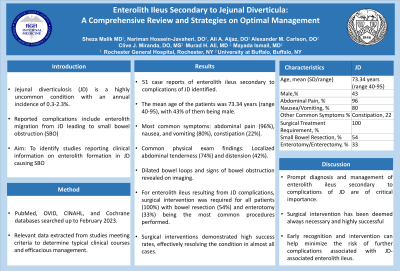Tuesday Poster Session
Category: Small Intestine
P4112 - Enterolith Ileus Secondary to Jejunal Diverticula: A Comprehensive Review and Strategies on Optimal Management
Tuesday, October 24, 2023
10:30 AM - 4:00 PM PT
Location: Exhibit Hall

Has Audio
- SM
Sheza Malik, MD
Rochester General Hospital
Rochester, NY
Presenting Author(s)
Sheza Malik, MD1, Nariman Hossein-Javaheri, DO2, Ali A.. Aijaz, DO2, Alexander M. Carlson, DO2, Clive J. Miranda, DO, MS2, Murad H. Ali, MD2, Mayada Ismail, MD2
1Rochester General Hospital, Rochester, NY; 2University at Buffalo, Buffalo, NY
Introduction: Jejunal diverticulosis is a highly uncommon condition with an annual incidence of 0.3-2.3%. Complications arising from jejunal diverticula (JD) are even rarer. Among the reported complications, enterolith migration from JD leading to small bowel obstruction (SBO) has only been described in isolated case reports and a comprehensive review of existing literature on this topic is currently lacking. Our study aims to conduct a thorough review of available case reports and provide a comprehensive summary of current understanding of enterolith ileus secondary to JD complications with investigation into optimal management of this pathology.
Methods: A comprehensive search of PubMed, OVID, CINAHL, and Cochrane databases up to February 2023 was conducted to identify studies reporting clinical information on enterolith formation in JD causing SBO. Relevant data were extracted from studies meeting criteria to determine typical clinical courses and efficacious management.
Results: Our literature review identified 51 case reports of enterolith ileus secondary to complications of JD. The mean age of the patients was 73.34 years (range 40-95), with 43% of them being male. The most common symptoms reported were abdominal pain (96%), nausea, and vomiting (80%), followed by constipation (22%). Understandably, localized abdominal tenderness (74%) and distension (42%) were common physical exam findings. The most common diagnostic modalities were abdominal X-rays and computed tomography scans, all of which consistently revealed dilated bowel loops and signs of bowel obstruction. Medical management has gained favor in recent years for enterolith ileus, particularly secondary to complications of duodenal diverticulosis. However, for enterolith ileus resulting from JD complications, surgical intervention was required for all patients (100%) with bowel resection (54%) and enterotomy (33%) being the most common procedures performed. These surgical interventions demonstrated high success rates, effectively resolving the condition in almost all cases.
Discussion: Prompt diagnosis and management of enterolith ileus secondary to complications of JD are of critical importance. As surgical intervention has been deemed always necessary and highly successful based on prior literature, we recommend against initial conservative management for these pathologies. Early recognition and intervention can help minimize the risk of further complications associated with JD-associated enterolith ileus.
Disclosures:
Sheza Malik, MD1, Nariman Hossein-Javaheri, DO2, Ali A.. Aijaz, DO2, Alexander M. Carlson, DO2, Clive J. Miranda, DO, MS2, Murad H. Ali, MD2, Mayada Ismail, MD2. P4112 - Enterolith Ileus Secondary to Jejunal Diverticula: A Comprehensive Review and Strategies on Optimal Management, ACG 2023 Annual Scientific Meeting Abstracts. Vancouver, BC, Canada: American College of Gastroenterology.
1Rochester General Hospital, Rochester, NY; 2University at Buffalo, Buffalo, NY
Introduction: Jejunal diverticulosis is a highly uncommon condition with an annual incidence of 0.3-2.3%. Complications arising from jejunal diverticula (JD) are even rarer. Among the reported complications, enterolith migration from JD leading to small bowel obstruction (SBO) has only been described in isolated case reports and a comprehensive review of existing literature on this topic is currently lacking. Our study aims to conduct a thorough review of available case reports and provide a comprehensive summary of current understanding of enterolith ileus secondary to JD complications with investigation into optimal management of this pathology.
Methods: A comprehensive search of PubMed, OVID, CINAHL, and Cochrane databases up to February 2023 was conducted to identify studies reporting clinical information on enterolith formation in JD causing SBO. Relevant data were extracted from studies meeting criteria to determine typical clinical courses and efficacious management.
Results: Our literature review identified 51 case reports of enterolith ileus secondary to complications of JD. The mean age of the patients was 73.34 years (range 40-95), with 43% of them being male. The most common symptoms reported were abdominal pain (96%), nausea, and vomiting (80%), followed by constipation (22%). Understandably, localized abdominal tenderness (74%) and distension (42%) were common physical exam findings. The most common diagnostic modalities were abdominal X-rays and computed tomography scans, all of which consistently revealed dilated bowel loops and signs of bowel obstruction. Medical management has gained favor in recent years for enterolith ileus, particularly secondary to complications of duodenal diverticulosis. However, for enterolith ileus resulting from JD complications, surgical intervention was required for all patients (100%) with bowel resection (54%) and enterotomy (33%) being the most common procedures performed. These surgical interventions demonstrated high success rates, effectively resolving the condition in almost all cases.
Discussion: Prompt diagnosis and management of enterolith ileus secondary to complications of JD are of critical importance. As surgical intervention has been deemed always necessary and highly successful based on prior literature, we recommend against initial conservative management for these pathologies. Early recognition and intervention can help minimize the risk of further complications associated with JD-associated enterolith ileus.
Disclosures:
Sheza Malik indicated no relevant financial relationships.
Nariman Hossein-Javaheri indicated no relevant financial relationships.
Ali Aijaz indicated no relevant financial relationships.
Alexander Carlson indicated no relevant financial relationships.
Clive Miranda indicated no relevant financial relationships.
Murad Ali indicated no relevant financial relationships.
Mayada Ismail indicated no relevant financial relationships.
Sheza Malik, MD1, Nariman Hossein-Javaheri, DO2, Ali A.. Aijaz, DO2, Alexander M. Carlson, DO2, Clive J. Miranda, DO, MS2, Murad H. Ali, MD2, Mayada Ismail, MD2. P4112 - Enterolith Ileus Secondary to Jejunal Diverticula: A Comprehensive Review and Strategies on Optimal Management, ACG 2023 Annual Scientific Meeting Abstracts. Vancouver, BC, Canada: American College of Gastroenterology.
